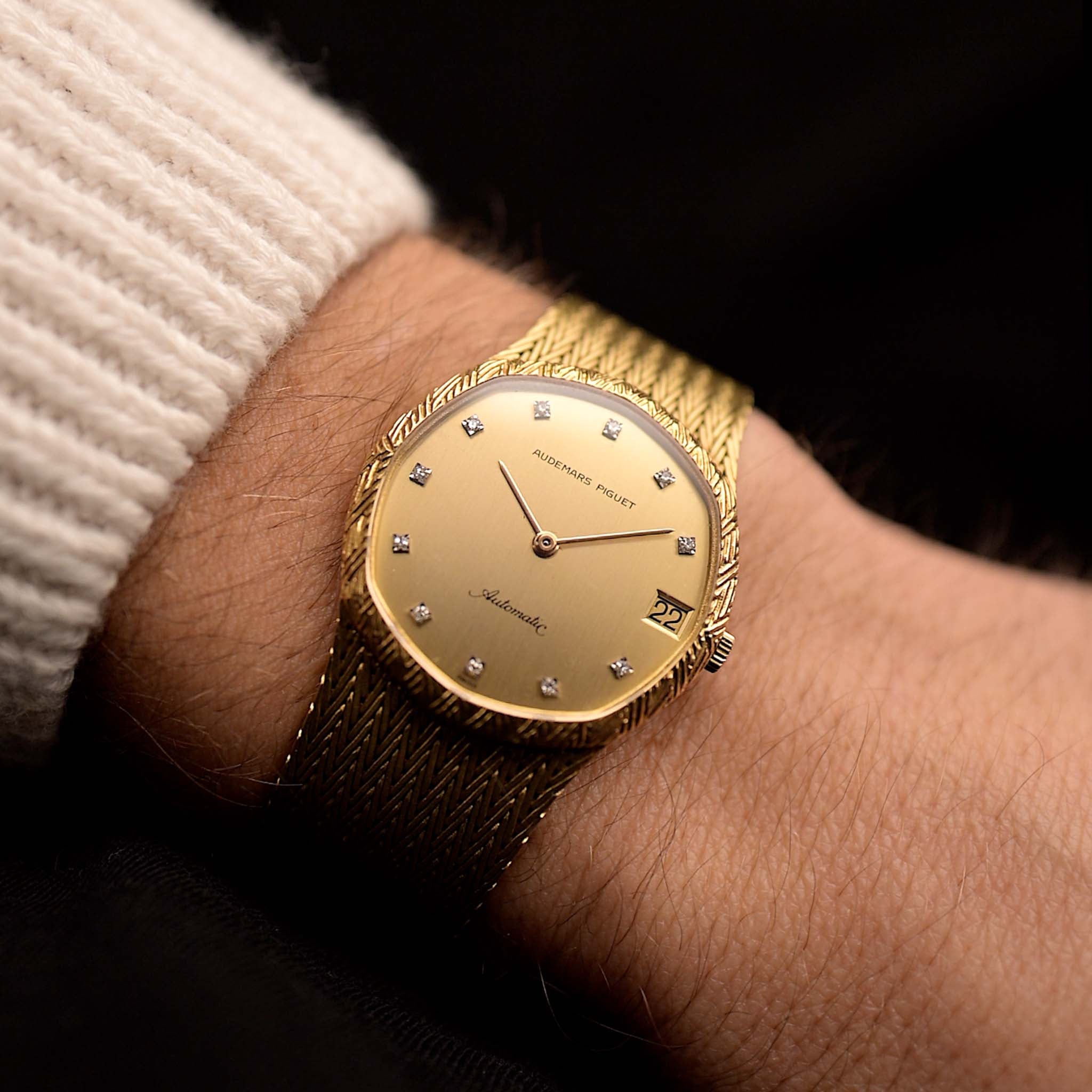This is the second part of our quest to the golden age of chronographs. This time it's all about purpose. Why do people want to stop the time? Keeping track of a race, navigating, or do you don’t actually need to clock the time but rather want a fine piece of classic horology? A good design takes all these reasons into account and is well aligned with the purpose. But what if not a single individual has a certain preference on how to use a chronograph but an entire generation? This is how styles and icons are born and the raison d'être for this entire series.
October 19, 2021
Golden Age of the Chronograph - Elegance & Utility
 Marcus Siems @siemswatches
Marcus Siems @siemswatches
Collector, Author, Data Analyst
This is the second part of our quest for the golden age of chronograph watches. This time I'll have a closer look at why people wanted to stop the time. Do you need to keep track of a race, are you navigating on land, water, in the air, or do you technically don’t need to clock the time but rather simply want a fine piece of classic horology? A good design takes all these reasons into account and is well aligned with the purpose. But what happens if not a single individual has a certain preference on how to use a chronograph but an entire generation? This is how styles and icons are born and the raison d'être for this entire series. And the perfect tool to answer these questions is quantitative data analysis - with data from more than 4000 watches, including about 800 chronographs - publicly listed on chrono24[1]
Every purpose can be translated into a broader definition of chronograph sub-types: The dressy, the sporty and the military chronograph. Each purpose being impersonated by their own distinct design characteristics.
 There are so many things you can do with a chronograph... timing a race, calculating travel speed, navigating, control oxygen use while diving, cooking eggs - the options are limitless. Photo @goldammer.me
There are so many things you can do with a chronograph... timing a race, calculating travel speed, navigating, control oxygen use while diving, cooking eggs - the options are limitless. Photo @goldammer.me
A military chronograph usually features full Arabic numerals, luminous materials, likely a black dial and often is associated with aviation. A sporty specimen typically comes in stainless steel and is built for the active lifestyle - for racing, diving or civilian aeronautics. And finally we got dressy chronographs. Well, they usually don’t fit into the other two categories but are the ones that just look extremely posh. They’re often made from precious metals, more so than not come on a strap, showcase more extravagant hands and marker designs and might even feature additional haute horologie complications.
In a similar way the dial color can help us classify a watch and might give us a good first impression about the purpose as well. Particularly black – and dark blue – is a color that is not only valued for its subtle elegance and design. The dark background is especially advantageous when luminous materials are applied[2], granting watches with increased legibility for example underwater or when flying a plane through the night sky. Basically, black is the color of choice for tool-oriented watches, or in our case typically for sporty and military chronos.
 Figure 2. Distribution of Chronograph sub-types and colors for the two periods. Around 1950 chronograph watches are mainly white-dialed dressy examples. This pattern completely shifts around 1970 as chronographs are becoming very sporty and are almost exclusively black or blue.
Figure 2. Distribution of Chronograph sub-types and colors for the two periods. Around 1950 chronograph watches are mainly white-dialed dressy examples. This pattern completely shifts around 1970 as chronographs are becoming very sporty and are almost exclusively black or blue.
Naturally, different generations have different styles. Yet it is very intriguing to see that the two ages are very distinct at the level of the broader application of the stop-watch complication as well.
The 1940s/50s chronograph is a very dressy and elegant timepiece sporting a white dial. The watch itself did serve mainly one purpose, celebrating the art and ingenuity of watchmaking. Back then the chronograph seems to not have been a tool for racing but rather a high-complication accessory, haute horologie. It has been the gentlemens’ favorite accessory. Around 1950 dress watches and dressy chronographs combine for more than 80% of all watches on the market, which makes it by every definition a dressy period. The two seem even so entangled that they share the same faith; they were quickly after 1950 outmaneuvered by new, modern tool-watches. Just a beautiful accessory is no longer enough, the first chronograph-wave abates and this period comes to a close.
Nevertheless, the chronograph reappears in the 1960s. But how does this complication become irresistible again? At the time people are more active, using watches in versatile ways at work and during leisure. Here, a stopwatch is actually quite useful: while driving around in your new car, watching sporting events, being out on the water yachting. Going full circle the chronograph is back with its original objective, and no longer a neat accessory. Sturdy, multi-purpose watches suit the contemporary taste best, just like the niche the chronograph was originally born into.
 Around 1970 sporty chronographs are the publics favorites - just like this 1960s icon, a Heuer Carrera 3647. Photo @goldammer.me
Around 1970 sporty chronographs are the publics favorites - just like this 1960s icon, a Heuer Carrera 3647. Photo @goldammer.me
What further fostered the success of this horological hero was undoubtedly the space-age mindset. Chronos are just perfect for aeronautics. And that epoch has seen the first chronograph in space[3,4], on the moon[5,6,7] and several more to orbit the earth[4,6,8,9]. And with every news coverage, every speed record, every new frontier conquered the chronographs reputation grew a little more until finally it established its footing as the overall bestselling watch-type.
Well-executed design serves a purpose. And just as versatile as the stopwatch complication can be, so diverse are its manifestations in the metal. However, not every style fits everyone’s taste and as we’ve seen we can treat different epochs almost like different people… the gentleman and the movie star. But these are just labels, we don’t know how they look like by now. Our example dials are still empty, naked. So let’s dress it up and see how to best case a chronograph.
The Golden Age of the Chronograph
Part I - History
Part II - Elegance & Utility
Part III - Case Design
Part IV - The Dial
Part V - The Essence
References
[1] Watches from Chrono24, extracted 2020 Nov. 29th; Karlsruhe, Germany;
[2] Luminous Dials, What Makes Them Glow, And How To Spot Their Differences; Jack Forster, Hodinkee;
[3] A Noteworthy Watch – Breitling’s “Scott Carpenter” Cosmonaute; Jeff Stein, OnTheDash;
http://www.onthedash.com/noteworthy-breitling-cosmonaute-scott-carpenter/
[4] 5 Watch Brands Involved in Space Exploration: Breitling, Fortis, Bell & Ross, Tag Heuer, Zenith; Roberta Naas, A Timely Perspective;
[5] The Omega Speedmaster history; Alessandro Mazzardo, Time And Watches;
https://www.timeandwatches.com/p/history-of-omega-speedmaster.html
[6] Alles über die Omega Speedmaster im Überblick; Redaktion, WatchTime;
https://www.watchtime.net/uhren-klassiker/alles-ueber-die-omega-speedmaster-im-ueberblick/
[7] How Omega’s Speedmaster ‘Moonwatch’ made space history; Rebecca Doulton, The Jewellery Editor;
http://www.thejewelleryeditor.com/watches/article/omega-speedmaster-moonwatch-history/
[8] The “Colonel Pogue” Seiko 6139; James Lamdin, DreamChrono Blog;
https://www.dreamchrono.com/2013/11/seiko-6139-pogue/
[9] Sinn in Space: the 140/142 Chronographs; James Lamdin, Worn&Wound;
https://wornandwound.com/sinn-in-space-the-140142-chronographs/
All rights on text and graphics reserved to the Author.




























Leave a comment